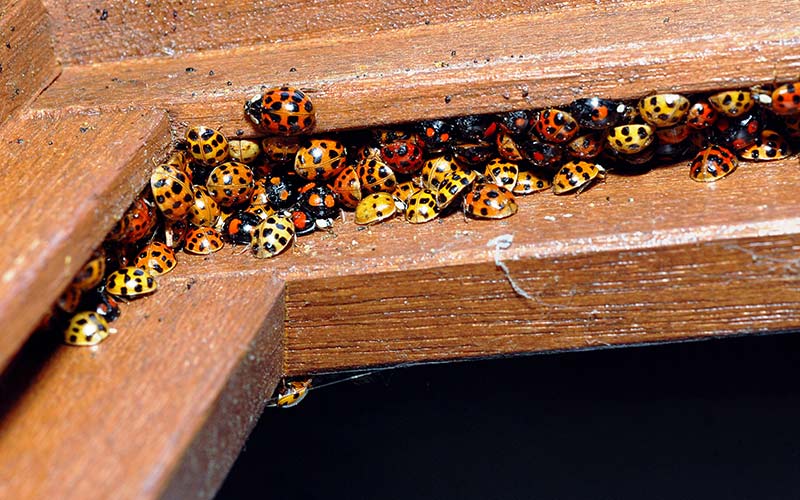How to Kill and Protect Against Asian Lady Beetles
Many invasive insect pests came to the United States by accident, often arriving in product shipments from faraway lands. But Asian lady beetles, also known as multicolored Asian lady beetles and harlequin ladybirds, were intentionally introduced to eat insect pests. Now found throughout the country, these insects threaten native ladybugs1 and invade homes in fall. By understanding these pests and their invasive nature, you can get rid of Asian lady beetles and protect your home.
- Identifying Asian Lady Beetles
- Understanding Asian Lady Beetle Damage
- Protecting Against Asian Lady Beetle Infestations

Identifying Asian Lady Beetles
Asian lady beetles look similar to native ladybugs, but these pests have a distinctive black "M" in the white area right behind their heads. The "M" shape can be thick, thin or broken, but it's clearly visible. Native ladybugs do not have that marking.
At 1/3 inch long, Asian lady beetles are rounder and larger than native ladybugs. Their colors and spots vary significantly. Asian lady beetles may appear red, orange, yellow or black. Spots on this invasive species range from none to 19 or more, with spots sometimes merging into larger patches.
Asian lady beetles can produce several generations per year. They lay clusters of yellow eggs on the undersides of leaves. Eggs hatch into larvae that mature into adult beetles in about one month. Asian lady beetles live up to three years.2
Often compared to miniature alligators, the black-and-orange Asian lady beetle larvae are larger than native ladybug larvae. But different species are hard to tell apart. To avoid harming native ladybugs, focus your treatment efforts on adult Asian lady beetles.

Understanding Asian Lady Beetle Damage
Asian lady beetles were introduced to the United States to fight aphids, a primary food for native ladybugs. These invasive Asian pests are still considered important aphid predators in U.S. agriculture. In home gardens, Asian lady beetles and their larvae eat plant-damaging aphids, mites, thrips and scale insects. But they also eat native ladybugs and their eggs. With their normal food source depleted and their eggs eaten, some native ladybug populations are at risk.
Asian lady beetles become major nuisances in fall. In search of winter shelter, they fly to surfaces that appear bright or illuminated. They swarm warm south- and west-facing walls of homes and gain entry under siding and through tiny openings around windows and doors. Infestations numbering in the tens of thousands are common, often plaguing the same structures year after year.3 Native ladybugs congregate for winter, but they don't invade homes.
Overwintering Asian lady beetles don't reproduce, but these pests emerge indoors on warm, sunny winter days. When disturbed, they emit a sticky orange substance that stains and stinks. They also can bite hard enough to break the skin. For many people, Asian lady beetle infestations and allergic reactions go hand in hand.

Protecting Against Asian Lady Beetle Infestations
In Asia, these multicolored lady beetles have native predators that feed on them and keep their numbers in check. But those natural predators remain in Asia. Controlling these pests falls to people instead. Effective Asian lady beetle control involves sealing any potential entry points and stopping these pests before they get inside.
With Amdro Quick Kill residual pesticides, you can create a powerful protective barrier before the fall onslaught starts. Amdro Quick Kill Insect Killer for Lawn & Landscape Ready to Spray and Amdro Quick Kill Insect Killer for Lawn & Landscape Concentrate work in minutes to kill existing Asian lady beetles by contact, then they keep protecting against new beetle arrivals for up to three months. These concentrated liquid products treat lawns, landscape plantings and building foundations up to a height of 2 feet.
Amdro Quick Kill Lawn Insect Killer Granules protects against Asian lady beetles in lawns and areas around your home. Applied according to directions with a regular lawn spreader, the granules kill Asian lady beetles by contact within 24 hours and keep killing these pests for up to three months. Amdro Quick Kill Insect Killer for Home Perimeter granules create a perimeter of protection immediately surrounding your home. The easy-to-use granules kill Asian lady beetles by contact and keep protecting against these pests for up to three months.
When Asian lady beetles threaten to disrupt your home, you can take action to stop their advance before it starts. Amdro brand products are here to help you get rid of Asian lady beetles, protect your family's peace of mind and get back to enjoying your home and yard.
Always read product labels thoroughly and follow instructions.
Sources:
1. B. Gavrilles, "Invasive Ladybugs Eat Their Native Competition, but a Shared Enemy Determines Who Survives," University of Georgia.
2. M.F. Potter, et al., "Asian Lady Beetle Infestation of Structures," University of Kentucky Entomology.
3. R.F. Mizell III, "Multicolored Asian Lady Beetle," University of Florida.




